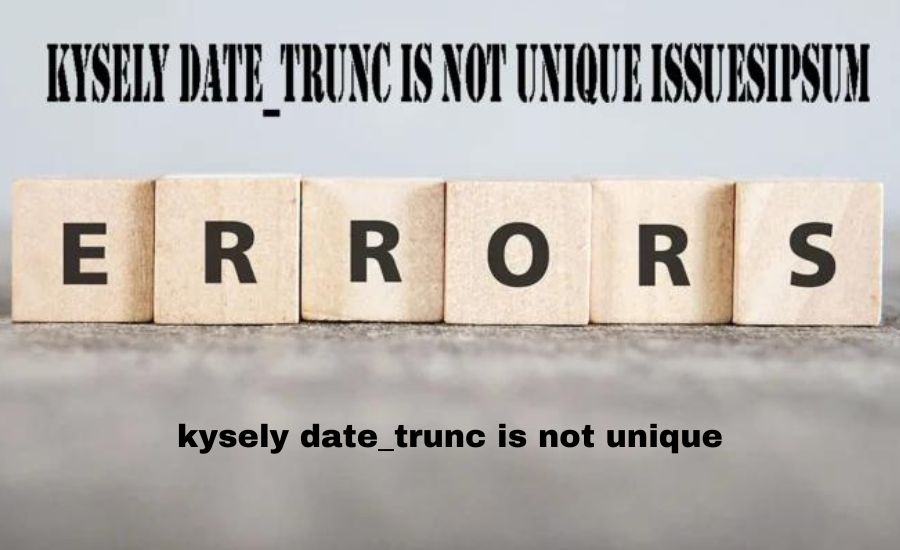Kysely date_trunc is not unique—this might sound confusing, but don’t worry! If you’re working with databases using Kysely, you may have faced this issue where the kysely date_trunc is not unique and it causes problems in your data results. But guess what? Fixing this isn’t too hard, and I’m here to guide you through it.
In this blog post, we will learn why the kysely date_trunc is not unique problem happens and how you can solve it easily. Whether you’re new to databases or just want a simple solution, you’ll find everything you need right here. Let’s dive in and make those tricky database problems disappear!
Why Kysely Date_Trunc is Not Unique: Simple Explanation
When you use kysely date_trunc in your database queries, you might notice that it doesn’t always give unique results. This happens because the kysely date_trunc is not unique function trims down the date to a specific time unit like a day, hour, or minute. If multiple events happen in the same time unit, they end up looking the same after truncation.
Think of it like cutting the ends off of a string—if two strings are the same length after being cut, you can’t tell them apart anymore. In databases, this means your data might get lumped together, making it hard to see the details you need. This can be confusing when you need to see unique records but end up with duplicates.
Understanding this helps you avoid mistakes in your data analysis. By knowing that kysely date_trunc is not unique, you can plan ahead to keep your data clean and your results accurate.
Easy Fixes for Kysely Date_Trunc are Not Unique
Fixing the kysely date_trunc is not unique problem doesn’t have to be hard. One simple solution is to use a GROUP BY clause in your query. This helps by grouping your data based on the truncated date and keeping other important details unique.
Another quick fix is to combine the kysely date_trunc function with other functions, like COUNT or SUM. These functions allow you to add up or count the data within each group, so even if the dates are the same, the numbers stay unique.
It’s also helpful to check your data before you use kysely date_trunc. By cleaning up any duplicates beforehand, you can avoid the problem altogether. This way, your queries run smoothly, and your results are spot on.
How to Handle Non-Unique Results in Kysely Date_Trunc

Handling non-unique results when kysely date_trunc is not unique can be tricky, but it’s doable with the right approach. Start by identifying where the non-unique results are coming from. Often, it’s due to the truncation level being too broad, like truncating to just the day.
To fix this, you can use more precise truncation levels, like hours or minutes. This reduces the chances of different records being treated as the same. If your data still isn’t unique enough, consider using other data fields to differentiate the results.
Lastly, don’t forget to use DISTINCT in your query when necessary. This tells the database to only return unique records, helping you manage the non-unique issues when kysely date_trunc is not unique. With these steps, you’ll have more control over your data and get the accurate results you need.
Common Mistakes That Make Kysely Date_Trunc Not Unique
One common mistake that makes kysely date_trunc not unique is choosing the wrong truncation level. If you’re working with timestamps that need minute-level precision, truncating to just the day can cause problems. This mistake leads to different timestamps looking the same, even when they shouldn’t.
Another error is not checking your data for duplicates before using kysely date_trunc. If your data already has duplicates, truncating it won’t solve the problem—it might even make it worse. Always clean your data first to avoid this pitfall.
Finally, forgetting to account for time zones can mess up your results. If your data comes from different time zones but you don’t adjust for this before truncating, you’ll end up with misleading results. Avoid these mistakes, and you’ll keep your kysely date_trunc function working correctly.
Step-by-Step Guide: Solving Kysely Date_Trunc is Not Unique
Solving the kysely date_trunc is not unique issue can be easy if you follow a simple step-by-step guide. First, identify the level of truncation you need. Ask yourself whether you need to round off your dates to the nearest day, hour, or minute.
Next, check your data for any duplicates before applying the kysely date_trunc function. Cleaning up your data first ensures you won’t face issues later. After cleaning, apply the truncation with the GROUP BY clause to keep your data grouped correctly.
Finally, run your query and review the results. If you still see non-unique results, adjust your truncation level or add more details to your grouping. This step-by-step approach helps you tackle the kysely date_trunc is not unique problem with confidence.
How to Avoid Kysely Date_Trunc is Not Unique Issues in Your Queries
Avoiding the kysely date_trunc is not unique issue starts with careful planning. Before writing your query, decide on the correct truncation level for your data. If you’re unsure, start with a more precise level, like hours, to prevent grouping too many records together.
Another tip is to always clean your data before using the kysely date_trunc function. Removing duplicates early on reduces the chances of running into problems later. Also, consider using DISTINCT in your queries to ensure that only unique records are returned.
Lastly, test your query on a small dataset before running it on a larger one. This helps you catch any issues with kysely date_trunc early, so you can make adjustments before working with the full dataset. Following these steps will help you avoid common pitfalls and keep your data accurate.
Understanding Kysely Date_Trunc is Not Unique

The kysely date_trunc is not unique error can be confusing at first, but it’s important to understand why it happens. This error typically occurs when the truncation level is too broad, causing multiple records to share the same truncated date.
When you truncate to a broader time unit, like a day, any events that happen within that day will look the same after truncation. This leads to non-unique results, which can mess up your analysis or reports.
To prevent this error, choose a truncation level that matches the detail you need in your data. If necessary, add more fields to your grouping to maintain uniqueness. Understanding this error helps you take the right steps to fix it and keep your queries running smoothly.
Top Tips to Prevent Kysely Date_Trunc is Not Unique Problems
Preventing kysely date_trunc is not unique problems is all about taking the right precautions. One top tip is to always double-check your truncation level before running your query. If your data needs more precision, like down to the hour, make sure you don’t truncate to a day instead.
Another tip is to use DISTINCT in your queries whenever possible. This ensures that only unique records are returned, which helps avoid non-unique issues with kysely date_trunc.
Also, remember to clean your data first. Removing duplicates before truncating dates can save you from headaches later on. By following these tips, you’ll minimize the chances of running into problems and keep your data analysis on track.
What to Do When Kysely Date_Trunc is Not Unique
When kysely date_trunc is not unique, don’t panic! It can be fixed in a few ways. Start by reviewing your query and checking if the truncation level is appropriate. If the truncation level is too broad, try narrowing it down to a smaller unit, like hours or minutes.
Next, consider using aggregation functions like SUM or COUNT to group your data more effectively. This way, even if the dates aren’t unique, you’ll still get meaningful results.
If you still see issues, check your data for duplicates and clean it up before truncating the dates. By taking these steps, you’ll be able to handle the kysely date_trunc is not unique problem and get accurate results from your queries.
How Aggregation Helps Fix Kysely Date_Trunc is Not Unique

Aggregation functions like SUM and COUNT can be lifesavers when kysely date_trunc is not unique. These functions allow you to combine data that shares the same truncated date, making your results more meaningful.
For example, if you’re looking at daily sales, using SUM will add up all sales for each day, even if the dates aren’t unique after truncation. This gives you a clearer picture of your total sales without worrying about duplicates.
Using aggregation also helps when you need to group data by truncated dates. By combining records that share the same date, you ensure that your analysis is accurate and your results are easy to understand. Aggregation is a key tool in managing non-unique results with kysely date_trunc.
Best Practices for Using Kysely Date_Trunc Without Errors
Using kysely date_trunc without running into errors requires following some best practices. First, always choose the right truncation level for your data. If you need precision, don’t truncate too broadly—stick to hours or minutes if necessary.
Another best practice is to clean your data before applying kysely date_trunc. This means checking for and removing duplicates so that your results remain unique after truncation.
Additionally, use DISTINCT in your queries whenever possible to filter out non-unique records. By following these practices, you’ll reduce the chances of errors and make sure your kysely date_trunc function works as intended.
How Time Zones Affect Kysely Date_Trunc is Not Unique
Time zones can play a big role in why kysely date_trunc is not unique. If your data comes from different time zones and you don’t adjust for this before truncating, you might end up with unexpected results.
To avoid this, make sure all your timestamps are converted to the same time zone before applying kysely date_trunc. This ensures that your dates are consistent, and you won’t run into issues with non-unique results.
Also, consider how daylight saving time might affect your data. Adjusting for time zone differences and daylight saving can help you get more accurate results when using kysely date_trunc.
Simple Tricks to Keep Kysely Date_Trunc Results Unique
Keeping kysely date_trunc results unique doesn’t have to be hard. One simple trick is to use the DISTINCT keyword in your queries. This ensures that only unique records are returned, even after truncation.
Another trick is to combine kysely date_trunc with other functions like ROW_NUMBER. This helps you assign a unique identifier to each row, making it easier to manage non-unique results.
Lastly, always clean your data before truncating dates. Removing duplicates beforehand reduces the chances of non-unique results. These simple tricks can make a big difference in keeping your kysely date_trunc results unique.
Must be aware of: Https//EntreTechOrg
The Impact of Duplicate Data on Kysely Date_Trunc

Duplicate data can have a big impact on why kysely date_trunc is not unique. When you have duplicate entries in your data, truncating the dates won’t fix the problem—in fact, it might make it worse by grouping those duplicates together.
To avoid this, always clean your data before applying kysely date_trunc. Removing duplicates early on ensures that your results stay unique and accurate.
If duplicates are unavoidable, consider using DISTINCT or combining truncation with aggregation functions. This approach helps manage the impact of duplicates and keeps your analysis on track.
Advanced Tips: Ensuring Kysely Date_Trunc is Always Unique
Ensuring that kysely date_trunc is always unique might require some advanced tips. One strategy is to use subqueries to isolate unique records before applying kysely date_trunc. This way, you start with clean data and avoid non-unique results.
Another advanced tip is to use window functions like ROW_NUMBER to assign unique identifiers to each row. This adds an extra layer of uniqueness to your data, even after truncation.
Finally, consider the order in which you apply functions in your query. Sometimes, changing the order can make a big difference in maintaining unique results. By using these advanced tips, you’ll be able to handle even the trickiest kysely date_trunc scenarios with ease.
Conclusion
Kysely date_trunc is not unique at first, but with the right steps, it becomes easier. By understanding why this problem happens and using simple fixes like cleaning your data, choosing the right truncation level, and using functions like DISTINCT, you can keep your data unique and accurate. Remember, even though it might take a bit of practice, these tools will help you solve the problem and get better results in your database work.
Always keep in mind that planning your queries carefully and testing them with smaller datasets first can save you from bigger issues later. With these tips and tricks, you’ll be able to handle kysely date_trunc without any stress, making your work smoother and more efficient. Happy querying!
Get Latest Blog On: Vista Glimpse
FAQs About kysely date_trunc is not unique
Q: What does it mean when Kysely date_trunc is not unique?
A: It means that after truncating dates, multiple records end up with the same date, making them look identical. This can cause issues in data analysis or reporting.
Q: How can I fix the Kysely date_trunc is not unique issue?
A: You can fix it by using functions like GROUP BY or DISTINCT to ensure your data remains unique after truncation. Cleaning up duplicates before truncation also helps.
Q: Why do I get duplicate results with Kysely date_trunc?
A: Duplicate results occur because the truncation level is too broad, like truncating to the day when you need more precise times. This groups different records under the same date.
Q: Can adjusting the truncation level help with non-unique results?
A: Yes, using a more precise truncation level, like hours or minutes, can help differentiate records and reduce non-unique results.
Q: Is it important to clean my data before using Kysely date_trunc?
A: In order to ensure accurate analysis, your data needs to be cleaned to remove duplicates before truncation is applied.
Q: What is the best way to avoid non-unique results in Kysely date_trunc?
A: The best way is to use DISTINCT in your queries and to choose the correct truncation level that matches the detail needed in your data.
Q: Can time zones affect the Kysely date_trunc function?
A: Yes, differences in time zones can cause unexpected results. Ensure all timestamps are in the same time zone before truncating.
Q: What should I do if Kysely date_trunc still gives me problems?
A: Try combining truncation with other functions like ROW_NUMBER or SUM to better manage and differentiate your data. If issues persist, check your query structure and data format.


